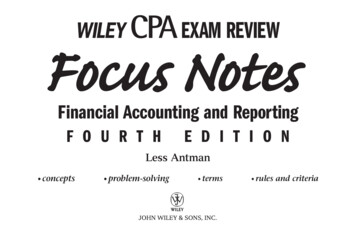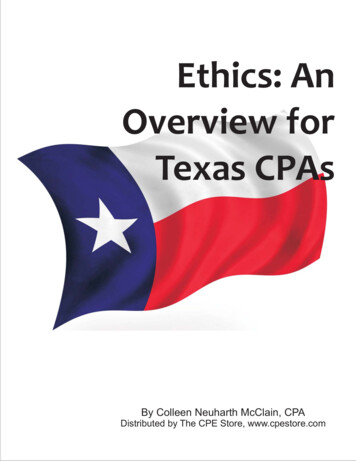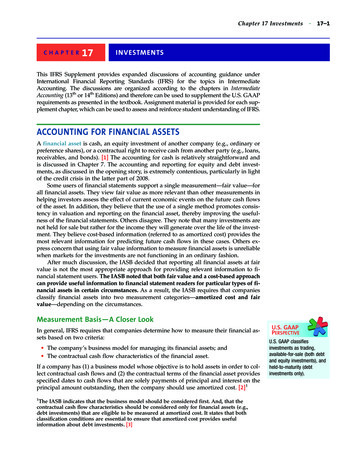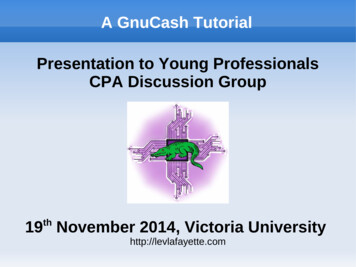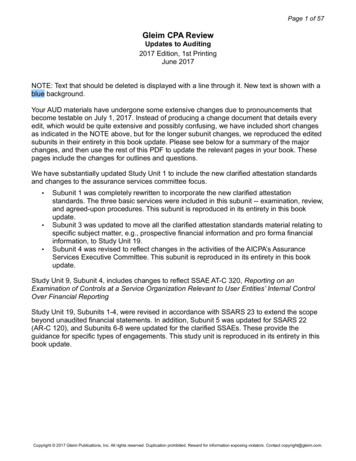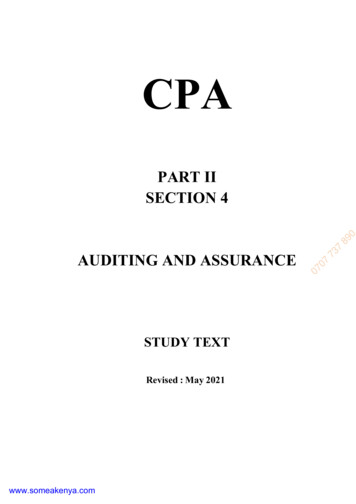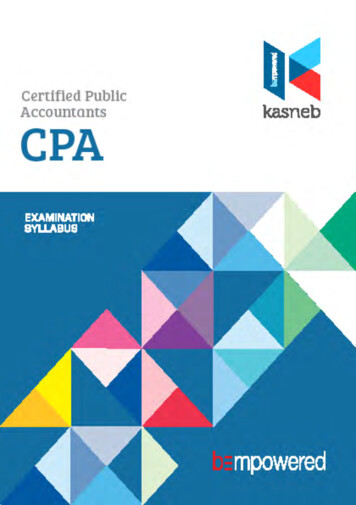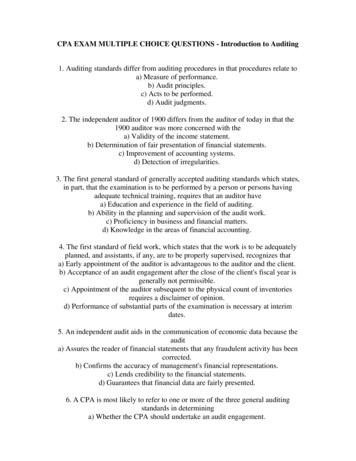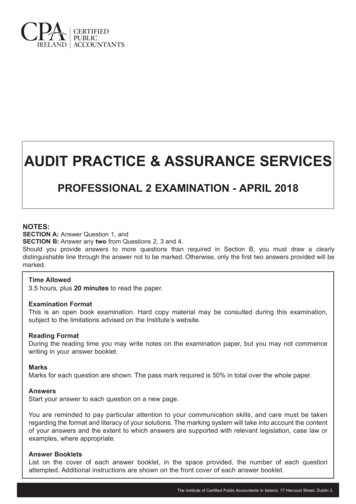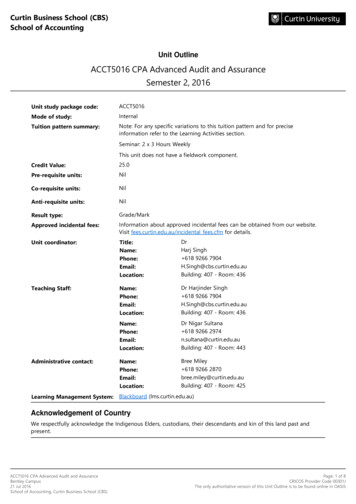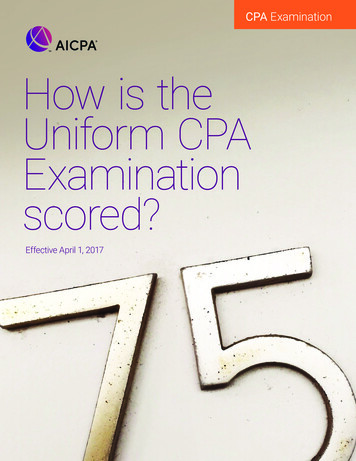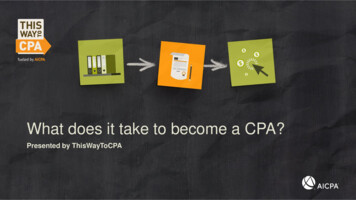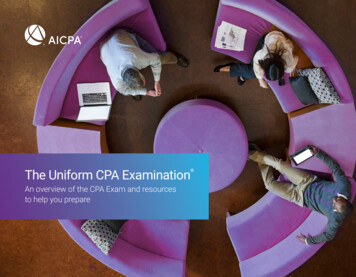
Transcription
The Uniform CPA Examination An overview of the CPA Exam and resourcesto help you preparei
The Uniform CPA Examination (Exam) protects the public interestby helping to ensure that only qualified individuals become licensed asU.S. Certified Public Accountants (CPAs). The CPA credential is the onlylicensing qualification in accounting and auditing in the United States.This booklet provides individuals interested in becoming a CPA withinformation about the profession, testing requirements and details,and candidate resources.ii
Contents2The CPA credential is in high demand.11Who oversees the Exam?3 Help us protect the public interest.12Exam application process4What can you expect from the Exam?13International candidates6Exam resources for you14Top CPA Exam tips8Top candidate FAQs15 Resources to help you prepare for the Exam10How does scoring work?1
The CPA credential is in high demand.Top five reasons to pursue the CPA.EarningpotentialCareeropportunitiesAccounting and auditingemployment growth is6%through 2028.Source: Bureau of Labor Statistics, U.S. Department of Labor,Occupational Outlook Handbook, Accountants and Auditors,September 20202StabilityFlexibilityPrestigeand respectWhile CPAs have always been in highdemand, the impact of COVID-19 hasmade their role even more urgent —now, and especially in the foreseeablefuture. As businesses across the countryare making critical operational decisionsbecause of closures and other adjustments,they’re turning to CPAs to help guide themwith forecasting, cash flow analysis, revenueand more.Source: NextGen — The NYSSCPA’s Professional Development Guide, June 2020
Help protect the public interest.So, you want to earn your CPA? The CPA is the onlylicensing qualification for the accounting and auditprofession in the United States. But first, you mustpass the Uniform CPA Examination .The 4 E’s to CPAlicensureOf the four requirements,only the Exam is uniformand accepted for CPAlicensure by all jurisdictions.Experience, education andethics requirements vary byjurisdiction.ExperienceThe Exam provides reasonable assurance to the 55 U.S.boards of accountancy (50 states plus the District ofColumbia, Puerto Rico, the U.S. Virgin Islands, Guam and theCommonwealth of the Northern Mariana Islands*) that thosewho pass possess the minimum level of technical knowledgeand skills necessary for initial licensure. The public interest isprotected when only qualified individuals are licensed as CPAs.EducationCPAEthics**Exam* The Commonwealth of the Northern Mariana Islands does not accept applicants for the Exam but does accept scores from other jurisdictions for initial licensure.** Most jurisdictions require a separate ethics assessment in addition to what is tested on the CPA Exam.3
What can youexpect from theExam?The Exam is a rigorous assessment of theaccounting knowledge and skills that aredirectly connected to the work of a newlylicensed CPA. Before you begin your CPAjourney, it’s important for you to learn thebasics about the Exam.Time frameEach section is taken separately. You will have four hoursto take each section, for a total testing time of 16 hours.You must pass all four sections within 18 months. Thestart of the 18-month time frame varies by jurisdiction.Visit nasba.org/cpaexam for clarification.Test availabilityTesting is available year-round, and scores are releasedon a rolling basis. For more information, and a listof jurisdictions that offer year-round testing, visitnasba.org/exams/continuous-testing.Four sections* Auditing and Attestation (AUD) Business Environment and Concepts (BEC) Financial Accounting and Reporting (FAR) Regulation (REG)* Each section is divided into small segments called testlets.There are five testlets per section.4BreaksYou can choose to pause the Exam timer to take a breakfor 15 minutes after the third testlet only, or you canchoose to continue testing and not pause yourExam timer. You may also take breaks after all othertestlets. However, the Exam timer can not be paused forthose breaks.
Item typesExam structureYou are tested using three types ofquestions (items):Welcome/launch code screens(five minutes)Multiple-Choice Questions (MCQ)MCQs appear in Testlets No. 1 and No. 2in each Exam section.Task-Based Simulations (TBS) Simulationsare case studies that allow you to demonstrateyour knowledge and skills by workingthrough a problem. TBSs typically requireyou to use spreadsheets and/or search theExam’s authoritative literature. TBSs appearin Testlets No. 3, No. 4 and No. 5 in eachExam section.Written Communication Tasks (WCT)Written communication tasks are foundonly in Testlet No. 5 of the BEC section.You will need to read a scenario and write aclear, coherent response. The directions willexplain the format of your response (e.g.,memo, letter, etc.)Optional standardized break(pause timer for 15 minutes)Survey(five minutes)SectionTestlet 1Testlet 2Testlet 3Testlet 4Testlet 5AUD36 MCQ36 MCQ2 TBS3 TBS3 TBSBEC31 MCQ31 MCQ2 TBS2 TBS3 WCT*FAR33 MCQ33 MCQ2 TBS3 TBS3 TBSREG38 MCQ38 MCQ2 TBS3 TBS3 TBSConfidentiality/introduction/copyrightscreen (five minutes)Optional breaks(timer runs)* Written communication tasks for BEC onlyExam resourcesAuthoritative literatureYou will have access to authoritative literaturein each Exam section and can searchinformation to be used in completing simulations.5
Exam resources for youSample testsThe sample tests use the same software that you will betested on in a Prometric test center. There is one sampletest for each Exam section. You can practice with thequestion types, tools and resources that you will experienceduring the live Exam.Tutorial and sample testsBefore your actual test day, be sure to practice with theExam’s format and functionality. Also check out some helpfulshort videos for highlights about the CPA Exam software.You’ll find various topics that discuss the functionality oftools, resources and navigation found in the Exam.TutorialThe tutorial topics explain the Exam’s functionality of questiontypes, tools, resources and navigation. Tutorial topics arefound under the “Help” button within each sample test. Thetutorial does not contain actual Exam content. The helpbutton will also be available to you when testing in aPrometric Test Center.6You can answer test questions that represent all the questiontypes found on the Exam: Multiple-Choice Questions (MCQ),Task-Based Simulations (TBS) and Written CommunicationTasks (WCT). The sample questions provide an answer key(or sample answer for the WCT questions), along with ananswer rationale for the TBS questions, but don’t necessarilyreflect your readiness to take the Exam.Access the tutorial and sample tests at aicpa.org/cpaexam.The best starting point for anycandidate preparation is the CPAExam Blueprints, which detail thecontent knowledge and skills eligiblefor testing on the Exam.
CPA Exam BlueprintsThe Blueprints, which are published one or two times per year, outline all contentthat is eligible for testing in each Exam section. The Blueprints give you: Content organized by area, group and topic, along with score weighting Sample task statements that represent what you may be asked to dowhen testing Skill levels at which tasks are tested Reference materials that support the sample task statements Number of item types you must complete (multiple-choice questions,tasked-based simulations and written communication tasks), along withscore weightingAccess the Blueprints at aicpa.org/examblueprints.7
Top candidate FAQsQ: What’s the right order to take each section ofthe Exam?A: There’s no right order. It varies by individual preference.It’s up to you to determine the right order for yourself.Q: How long should I study to ensure I pass theExam?A: Like the answer above, this really varies by individual.Some can pass all sections with just a few hours ofstudying per week, while others may need 25 or morehours of studying per week to pass. As this is a rigoroustest, the more time you can set aside to study andprepare, the greater your chances of success.Q: Do all candidates take the same Exam?A: You will take different, but equivalent exams. Thequestions presented to you are drawn from a pool oftest questions according to defined specifications.Although you take different exams, the specificationsensure that the results are comparable.8
Q: H ow do I find out when new content is eligiblefor testing on the Exam?Q: What are the semester-hour requirements?A: This is referred to as the AICPA’s Policy on NewPronouncements, which establishes the time framefor when new content becomes eligible for testingon the Exam. When you study for the Exam, you areadvised to check the policy, which may be found ataicpa.org/cpaexam under the Exam study materialssection. Additionally, the Exam Blueprints, which outlineall content eligible for testing on each Exam section,are updated 1–2 times a year, and can be found ataicpa.org/examblueprints.A: All jurisdictions require aspiring CPAs to have 120 or150 credit hours to sit for the Exam, depending onthe jurisdiction, and 150 credit hours for licensure.Candidates generally will need at least 24 semesterhours in accounting. Candidates generally will need atleast 24 semester hours in accounting and business,respectively, though some states require more or fewer.This doesn’t necessarily mean that you need a master’sdegree, although that certainly helps. You can also meetthe requirement at the undergraduate level or earn yourbachelor’s degree and take courses at the graduate level.Q: What happens after I pass the Exam?Q: What are the experience requirements?A: Passing all four sections of the Exam means that youhave achieved one of the major milestones on the wayto becoming licensed. Once you pass, and have met allother requirements, all that stands between you and yourcareer as a CPA is a state-issued license.A: Most jurisdictions require a year of experience workingunder a licensed CPA before they allow you to be licensedas a CPA, though some require two or more years ofexperience.Q: What are the jurisdiction requirements?A: Each jurisdiction is different. Be sure to check theirindividual requirements at nasba.org/cpaexam.9
How does scoring work?What’s a passing score?Section scores are reported on a scale that ranges from 0 to 99.A total reported score of 75 or higher is required to pass eachsection. This is not a percentage of the correct score andcannot be interpreted as a percentage. For more informationon how the Exam is scored, visit aicpa.org/examscoring.When will I receive my score?See the target score release dates ataicpa.org/examscorerelease.The Elijah Watt Sells AwardThe AICPA has bestowed the ElijahWatt Sells Award on candidates foroutstanding performance on theExam since 1923.Candidates are eligible for the award in thecalendar year following the year in which theycompleted testing. If a candidate meets all criteriafor eligibility, they will be contacted by the AICPAand informed of their recipient status. The awardis bestowed annually upon candidates who: Have obtained a cumulative average scoreabove 95.50 across all four sections of theCPA Exam Passed all four sections of the Exam on theirfirst attemptSells was one of the country’s first CPAs. He wasactive in the establishment of the AICPA, andplayed a key role helping to advance professionaleducation in the profession.10
Who overseesthe Exam?Who administers the Exam?The AICPA, the National Association of State Boards ofAccountancy (NASBA) and Prometric have a contractualpartnership to deliver the Exam.In addition to being the world’s largest memberassociation representing the accounting profession,the AICPA also is responsible for developing andscoring the Uniform CPA Exam and for bringing youThisWayToCPA.com, a website designed specificallyfor college students and Exam candidates.For more information on the requirements to sit for the CPAExam, visit nasba.org/cpaexam.Who oversees governance of the Exam?The AICPA Board of Examiners (BOE) provides oversight forthe Exam. The BOE sets development and scoring policiesthat follow legal and psychometric standards as they relateto the profession’s licensing exam. The BOE also ensuresthat the Exam remains aligned with the knowledge and skillsof newly licensed CPAs.After you have made your decision to sit for the Exam,NASBA is the official location to find out the specificrequirements in the 55 U.S. accounting jurisdictions.Many states have candidates apply to take the Examthrough NASBA’s CPA Examination Services (CPAES).It’s also the place to turn to receive your officialscore report.Prometric is responsible for the delivery of the Exam toapproved test centers, scheduling test appointments,test administration and returning results to the AICPAfor scoring.1111
Exam application processDetermine eligibility.Submit application.Schedule your exam. Check with your selected jurisdictionon requirements to sit for the Exam(state requirements vary between120 or 150 hours of education). Complete application and submitrequired documentation. Schedule your exam withPrometric after receiving NTS. Application is evaluated to verifyeligibility to sit for the Exam. Any U.S. Prometric test center canbe used regardless of jurisdiction. Meet eligibility requirements forselected jurisdiction. Candidates receive Notice toSchedule (NTS). International locations require anadditional fee. NTS is valid for six months in mostjurisdictions (varies by state).For more information on your individual state board’s requirements, visit nasba.org/cpaexam.12
International candidatesCan I earn my CPA license if I’m not a U.S. citizen?If you are not a U.S. citizen, you may earn a U.S. Certified PublicAccountant (CPA) license if you meet board of accountancyeligibility requirements in one of the 55 U.S. jurisdictions. Youmust be able to take the Exam in English. It is not offered in
The Uniform CPA Examination (Exam) protects the public interest by helping to ensure that only qualified individuals become licensed as U.S. Certified Public Accountants (CPAs). The CPA credential is the only licensing qualification in accounting and auditing in the United States. This booklet provides individuals interested in becoming a CPA .File Size: 2MBPage Count: 20
